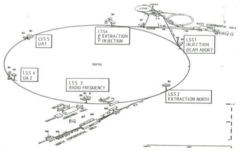Antiproton Accumulator
 |
|
| Key SppS Experiments | |
|---|---|
| UA1 | Underground Area 1 |
| UA2 | Underground Area 2 |
| UA4 | Underground Area 4 |
| UA5 | Underground Area 5 |
| SppS pre-accelerators | |
| PS | Proton Synchrotron |
| AA | Antiproton Accumulator |
The Antiproton Accumulator (AA) was an infrastructure connected to the Proton-Antiproton Collider (SppS) — a modification of the Super Proton Synchrotron (SPS) — at CERN. The AA was built in 1979 and 1980, for the production and accumulation of antiprotons. In the SppS the antiprotons were made to collide with protons, achieving collisions at a center of mass energy of app. 540 GeV (later raised to 630 GeV and finally, in a pulsed mode, to 900 GeV). Several experiments recorded data from the collisions, most notably the UA1 and UA2 experiment, where the W and Z boson were discovered in 1983. The concept of the project was developed and promoted by C. Rubbia, for which he received the Nobel prize in 1984. He shared the prize with Simon van der Meer, whose invention of the method of made large scale production of antiprotons possible for the first time.
Antiprotons were produced by directing an intense proton beam at a momentum of 26 GeV/c from the Proton Synchrotron (PS) onto a target for production. The emerging burst of antiprotons had a momentum of 3.5 GeV/c, and was selected via a spectrometer, and injected into the AA. The produced antiprotons would have a substantial momentum spread, and during 2 s orbit around the AA this spread was decreased using Simon van der Meers method of . The antiprotons were then trapped using a radiofrequency system, and moved inwards in the orbit to a stacking region. A next burst of antiprotons arrived at 2.4 s (the PS cycle time) after the preceding one. This process was repeated during the whole accumulation period, which took about a day. The most intense stack, obtained after many days, would typically contain 5.2·1011 antiprotons.
...
Wikipedia
